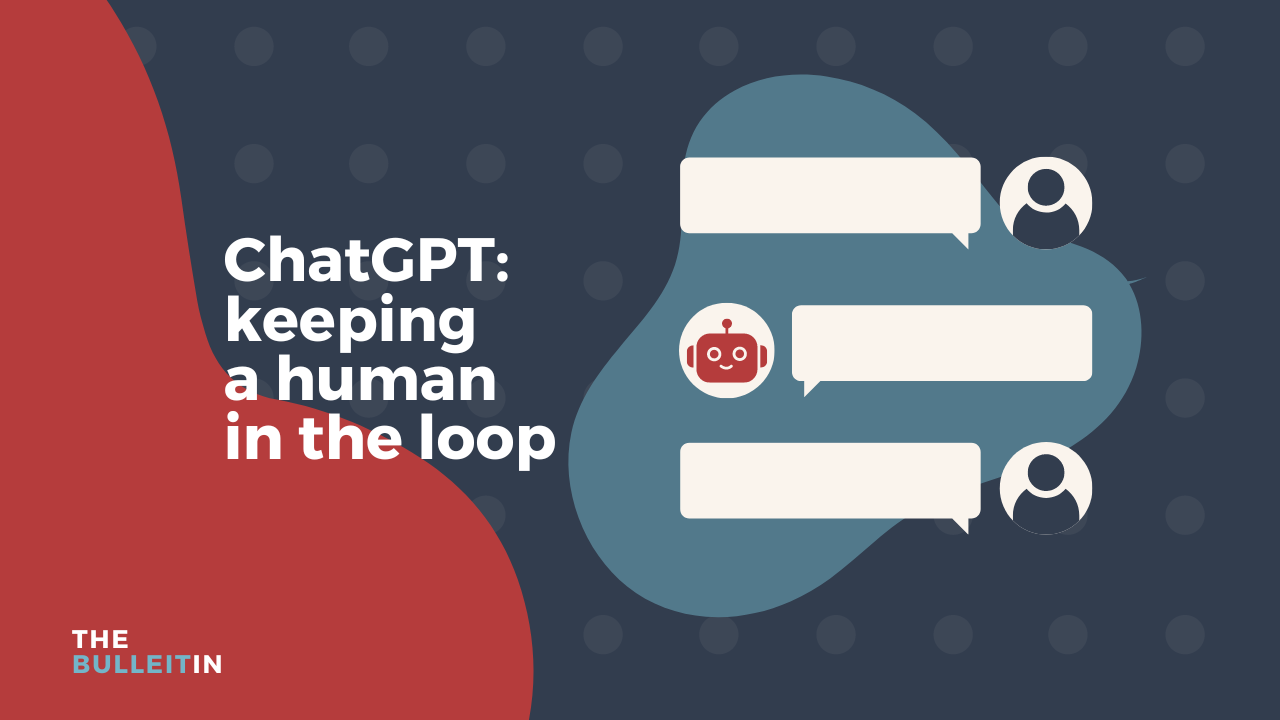
Communications post-ChatGPT: keeping a human in the loop
Nothing has hit tech media quite like ChatGPT. When it was released in November 2022, the optimized version of OpenAI’s previous InstructGPT model quickly rocketed to the top of the news cycle and has stayed there since, even as layoffs and slashed funding continue to roil the industry.
Some of the media fervor can be attributed to ChatGPT’s obvious relevance to anyone who writes professionally. Technology that can automate the messy process of translating ideas into copy ostensibly threatens journalists, authors, and more. Yet for many founders and managers, generative tools powered by large language models (LLMs) instead represent a solution to productivity and staffing woes. Why spend hours wrangling mission statements or thought leadership when AI can handle it in seconds?
As a content manager, at first, ChatGPT stunned me with its natural-sounding answers, delivered word by word. However, my trepidation quickly turned into a fascination with its capabilities and quirks, like a penchant for bland buzzwords and telling stories with neat, happy endings. But there’s no denying the disruptive moment; like others, I thought back to my first iPhone, recognizing a tool I will probably use daily for a variety of purposes.
AI has entered the chat, and there’s no going back. But rather than full automation of PR, marketing, and related disciplines, we’re entering a new era of human-machine collaboration. After all, ChatGPT owes its viral success to reinforcement learning with human feedback on conversation quality. In other words, the human in the loop remains essential.
Here are three ways to leverage and protect human ingenuity in AI-enabled communications:
The ultimate brainstorming buddy
ChatGPT produces seemingly original text, but it's actually a prediction of the most likely sequence of words based on its training data. For business users, this dynamic makes the hard work of communications fundamentals even more critical: crafting a singular voice, articulating a vision for the future, and finding your unique position in the market.
Where AI excels is in providing prototypes and jumping-off points. Not sure how to structure a press release? ChatGPT can provide dozens of options that you can refine without leaving the conversation. The same principle works in reverse. Companies trying to differentiate their products can now compare their marketing copy to LLM-generated examples to spot overused phrases or empty jargon.
Quantity and quality are the new standard
The amount of information online is set to explode; publishers are already struggling with a deluge of AI-assisted submissions. Journalists will expect truly unique perspectives to merit coverage, while customers will need to be convinced that scrolling your website is worth the time. Content that is commoditized or purely for SEO simply won’t find an audience.
Over time, AI will also shift expectations on how, when, and where companies engage. LLMs, perhaps fine-tuned on your style guide, will make it possible to deploy your narrative across more channels, faster: message boards, social media threads, product reviews—if your customers and competitors are there, you should be too.
No automation without accountability
LLM chatbots have a well-documented tendency to “hallucinate” facts. Meta pulled its science-focused Galactica demo offline after three days for inaccurate and biased responses. The bizarre exchange between a reporter and Microsoft’s ChatGPT-enhanced version of Bing made plain the capacity for these systems to veer dangerously off track.
That might not matter if you’re using the technology to riff on taglines, but the risk of reputational harm grows if public-facing functions are outsourced to intransparent AI-powered services. Nobody wants to get in a fight with a brand. Nor will the public have much sympathy for companies that blame their most recent blunder on a chatbot. Add AI fact checker to the list of tomorrow’s hottest jobs alongside prompt engineer.
Quality control will take on new importance as the line between humans and machines blurs. The role of communications teams will evolve in tandem, from a focus on creating discrete assets to managing the nonstop flow of information. In some cases, the time and effort required to edit AI outputs may beg the question: Why not just do it ourselves?
Don’t count out human creativity just yet
AI tools are just that—tools that can help you work faster or smarter, but they won’t think for you. Until we reach the long-theorized singularity, it’s still up to humans to make a case for their products and ideas on the global stage. And that’s probably for the best.
Alex Davis is a Content Manager with The Bulleit Group.

In each issue, we highlight interesting and newsworthy perspectives from the world of media and communications.
- Looking to learn more about how ChatGPT could affect your agency? PR professionals weigh in here on the pros and cons of ChatGPT and how this new technology will impact the PR profession.
- Government Technology shares how public affairs officials can use ChatGPT to save time when creating press releases and streamline city communications.
- The way we communicate at work could change as Slack just announced a new ChatGPT bot that can draft messages and summarize threads.